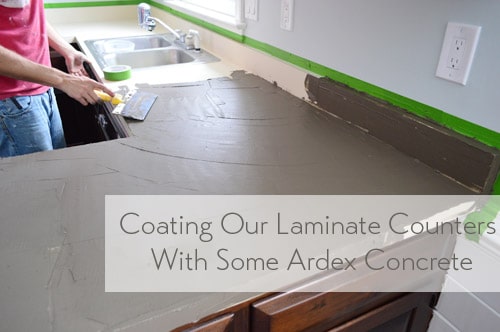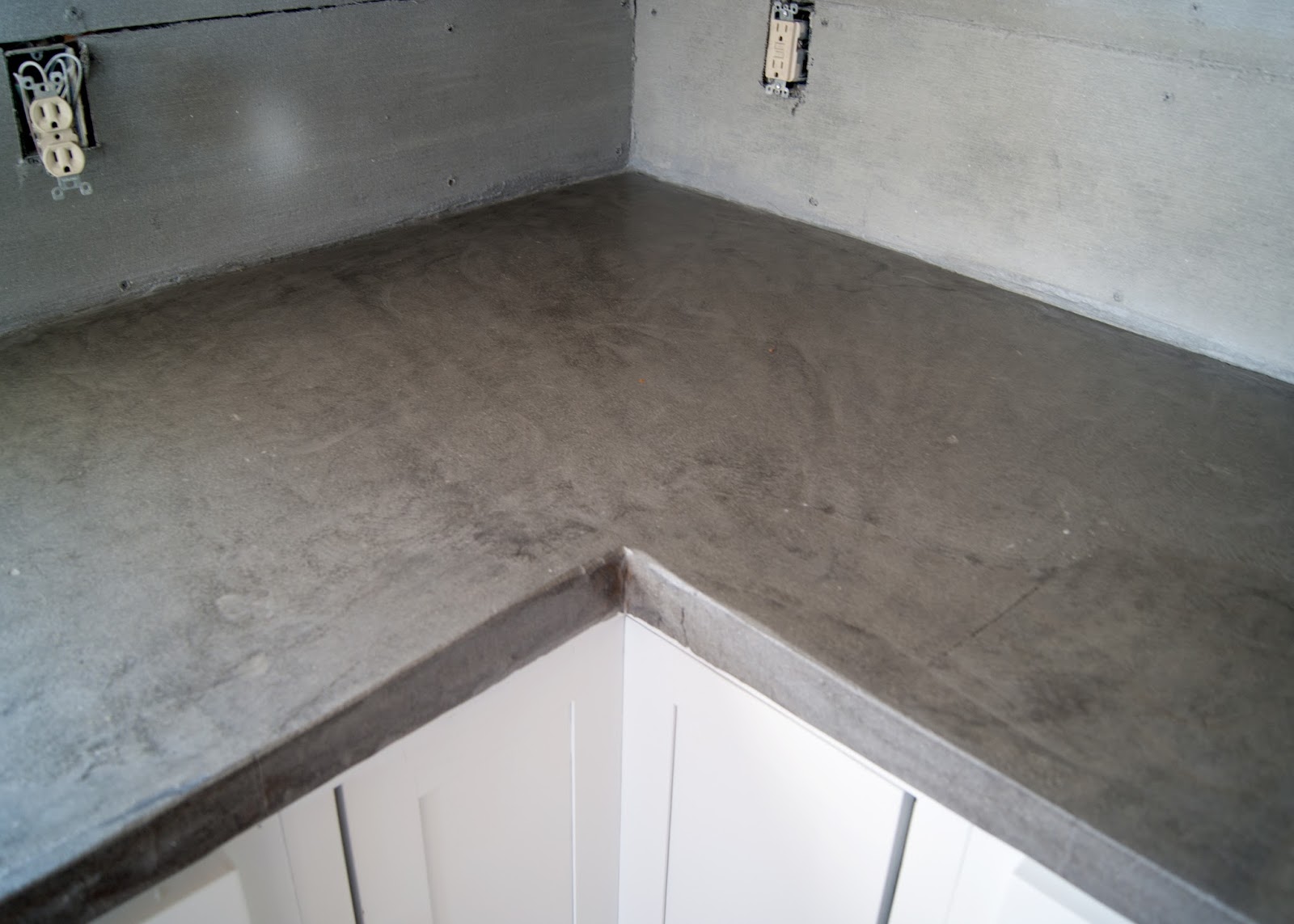Transforming your outdated kitchen or bathroom countertops can be a cost-effective and creative project with DIY concrete overlays. One popular approach is applying concrete over laminate countertops, which can revamp your space without needing a complete countertop replacement. The process of resurfacing laminate countertops with concrete not only adds a modern, industrial feel but also extends the lifespan of your counters. This DIY project is increasingly popular because it can be completed with basic tools and materials, offering homeowners a chance to achieve a high-end look on a budget.
Applying concrete over laminate involves several steps, starting with preparing the surface. Laminate countertops must be roughened to ensure proper adhesion between the existing surface and the concrete overlay. Sanding the laminate with coarse-grit sandpaper will create a textured surface, allowing the concrete to stick better. Additionally, filling in any chips, cracks, or deep scratches in the laminate is crucial to ensure a smooth final result. Applying a primer or bonding agent may also be necessary, depending on the type of concrete mix used.
Choosing the right concrete mix is another important aspect of this project. Not all concrete is created equal, and you’ll need to use a specially formulated concrete mix designed for thin overlays. Typically, these mixes contain additives that improve the strength and adhesion of the concrete, making them ideal for countertop applications. They are also more workable and can be applied in thin layers, which is important because laminate countertops cannot handle the weight of traditional, thick concrete layers. Popular choices for this kind of work include micro-topping concrete or feather-finish concrete mixes.
The application process itself is relatively straightforward but requires patience and attention to detail. After preparing the surface and choosing the appropriate concrete mix, you can begin by applying the first thin layer of concrete. This layer, often referred to as the scratch coat, is applied using a trowel or putty knife. The goal is to spread a thin, even coat across the entire surface of the countertop. The scratch coat acts as a foundation for subsequent layers, ensuring that the final result will be smooth and durable. It’s essential to let each layer fully dry before applying the next to avoid unevenness or cracks.
Once the scratch coat has dried, usually within a few hours depending on the product, additional layers of concrete can be applied. Each layer should be thin—typically no more than 1/8 of an inch thick. The process of layering thin coats ensures that the concrete adheres well to the laminate and prevents issues like cracking or peeling later on. As you build up the layers, you can smooth the surface with a trowel, adding texture or leaving it sleek, depending on your desired final appearance. Some DIYers choose to incorporate decorative techniques, such as lightly sanding between layers to create a polished, smooth finish.
An important consideration when applying concrete over laminate countertops is curing time. Concrete needs time to set and fully cure before it can be sealed and used regularly. While the concrete may appear dry on the surface within a day or two, it typically takes several days or even weeks to achieve full strength. Rushing the process can lead to imperfections, cracking, or even delamination. It’s important to follow the manufacturer’s instructions regarding drying and curing times to ensure the durability of your new countertop.
Sealing the concrete surface is the final and arguably the most critical step in the process. Concrete is a porous material, which means it can easily absorb stains, oils, and water if left unsealed. A high-quality sealer will protect the concrete from damage and make it easier to clean. There are different types of sealers available, including matte, satin, and glossy finishes, allowing you to customize the look of your countertop. Some sealers also add durability by making the surface scratch-resistant and more heat-tolerant, which is essential for kitchen use.

When selecting a sealer, consider the level of use your countertops will endure. In a high-traffic area like a kitchen, opt for a more durable, high-performance sealer that offers both water and stain resistance. For a bathroom or other low-traffic areas, a lighter sealer may suffice. Water-based polyurethane sealers are a popular choice for concrete countertops, as they provide a durable finish without yellowing over time. Multiple coats of sealer are usually required to ensure the surface is fully protected, with each coat needing time to dry before the next one is applied.
Maintenance for concrete-over-laminate countertops is relatively simple, provided the concrete has been sealed correctly. Daily cleaning can be done with a mild soap and water solution, avoiding harsh chemicals or abrasives that could damage the sealant. Depending on the type of sealer used, you may need to reapply it every few years to maintain the countertop’s durability and appearance. Small chips or cracks in the surface can be repaired with patching materials designed for concrete, ensuring the countertop remains in good condition over time.
Another advantage of DIY concrete overlays is their customization potential. You can tint the concrete with pigments to achieve different colors or even embed decorative items like stones, glass, or tiles into the surface for a unique, personalized touch. Concrete countertops offer a level of flexibility that other materials like granite or quartz simply cannot match, allowing homeowners to get creative with their design. With a little effort and imagination, you can create a truly one-of-a-kind countertop.
Cost is one of the major reasons homeowners turn to DIY concrete overlays. Traditional countertop materials, such as granite or quartz, can be expensive to purchase and install. However, concrete overlay projects typically cost a fraction of that price, especially if you already have a laminate surface in place that can be used as a foundation. The cost of materials like concrete, sandpaper, and sealant is relatively low, making this an affordable project for those on a budget. Plus, because it’s a DIY endeavor, you’ll save significantly on labor costs.

Durability is another factor that makes concrete overlays an attractive option. With proper sealing and maintenance, concrete countertops can last for many years, even in high-traffic areas. The strength of the material means that it can withstand daily wear and tear, and unlike laminate, concrete can be resurfaced or repaired if it becomes damaged. Over time, small imperfections may develop, but these can often be seen as adding character to the countertop rather than detracting from its appearance.
The aesthetic appeal of concrete is another key reason why this material has gained popularity in modern kitchens and bathrooms. Concrete countertops have a sleek, industrial look that complements a wide range of design styles, from contemporary to rustic. The ability to customize the color, texture, and finish makes concrete a versatile material that can work in almost any space. Whether you prefer a polished, glossy surface or a rougher, more textured look, concrete can be adapted to suit your style.
Environmental considerations are also part of the appeal of DIY concrete countertops. Using concrete as a resurfacing material can be a more sustainable option compared to purchasing new countertops made from mined materials like granite or marble. By reusing your existing laminate counters and adding a new surface, you reduce the amount of waste generated by your renovation project. Additionally, concrete is a relatively low-impact material in terms of production, especially when you compare it to other countertop options.

Common Mistakes to Avoid
One of the most common mistakes when applying concrete over laminate countertops is failing to properly prepare the surface. Without sufficient sanding or roughening of the laminate, the concrete won’t adhere properly, leading to delamination and peeling. Always take the time to sand the countertop thoroughly, ensuring a rough surface for the concrete to bond with.
Another mistake is applying layers that are too thick. While it may seem faster to put on one thick coat of concrete, this approach often leads to cracking as the concrete dries. Thin, even layers are crucial to prevent cracking and ensure a smooth finish. Make sure to allow each layer to dry fully before applying the next one.
Skipping the sealing step is another critical error. Unsealed concrete is highly porous and prone to staining, especially in a kitchen setting where food and liquids are frequently used. Skipping the sealer can lead to long-term damage and make cleaning difficult. Always finish your countertop with a high-quality sealer, applying multiple coats if necessary.
Additionally, many DIYers underestimate the curing time required for concrete countertops. While the surface may feel dry to the touch within a few days, the concrete underneath may still be curing. Using the countertops before they’ve fully cured can cause damage or unevenness in the finish. Be patient and follow the manufacturer’s recommendations for curing times.
Finally, poor mixing of the concrete can lead to issues like lumps, air bubbles, or uneven texture in the final result. Always mix the concrete thoroughly according to the product instructions, and avoid shortcuts that could compromise the quality of your finish. Proper mixing ensures a smooth, even application and reduces the likelihood of imperfections.

Can I apply concrete over any type of laminate countertop?
Yes, concrete can be applied over most types of laminate countertops, but proper preparation is essential. The surface must be sanded to create a rough texture that the concrete can adhere to. It’s also important to fill in any existing chips or cracks in the laminate before applying the concrete to ensure a smooth, even surface.
How thick should the concrete layers be when applying them over laminate?
Each layer of concrete should be very thin—typically no more than 1/8 inch thick. Applying thicker layers can lead to cracking or peeling as the concrete dries. Thin layers allow the concrete to adhere better to the laminate and provide a smoother finish. Multiple layers are applied, building up the thickness gradually.
How long does the concrete need to cure before I can use the countertops?
Curing times vary depending on the type of concrete mix used, but generally, you should wait at least a week before using the countertops regularly. The concrete may feel dry to the touch within a couple of days, but the material underneath is still curing and gaining strength. Following the manufacturer’s guidelines is essential for long-term durability.
What type of sealer should I use on my concrete countertops?
For concrete countertops, it’s best to use a water-based polyurethane sealer, which offers durability without yellowing over time. You can choose from matte, satin, or glossy finishes, depending on your style preference. Multiple coats are recommended for full protection against stains, moisture, and wear.
How do I maintain concrete countertops after they’re sealed?
Concrete countertops are relatively easy to maintain if they’ve been properly sealed. Clean them with a mild soap and water solution, avoiding harsh chemicals that could damage the sealant. Depending on the type of sealer used, you may need to reapply it every few years to keep the surface protected. Regular maintenance helps prevent stains and wear.
Can I add color or texture to my concrete countertops?
Yes, concrete is highly customizable. You can tint the concrete with pigments to achieve different colors or add texture with troweling techniques or by embedding decorative items like stones or tiles. This flexibility allows you to create a unique, personalized look that matches your kitchen or bathroom design.

Related articles:
- Retro Laminate Countertops
- Laminate Countertops For Bathroom
- Black Marble Laminate Countertop
- Painting Kitchen Laminate Countertops
- Quartz Laminate Countertops
- Laminate Countertops Installation
- Laminate Countertop For Kitchen Island
- Kitchen Island Laminate Countertops
- Cheap Laminate Countertops
- Laminate Countertops That Look Like Stone